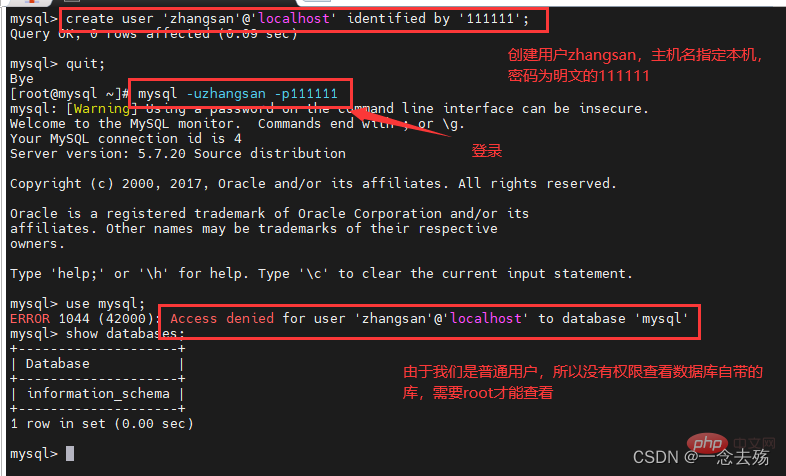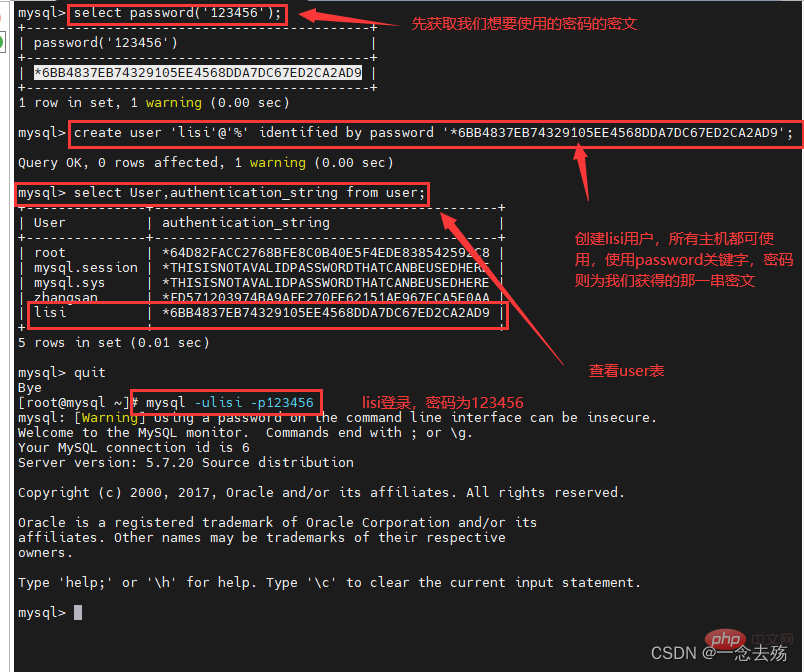rename user '旧用户名'@'旧主机名' to '新用户名'@'新主机名';
drop user '用户名'@'主机名';
Graphical examples analyzing MySQL user management
This article brings you relevant knowledge about mysql, which mainly introduces related content about user management, including creating new users, viewing user information, renaming users, deleting users, etc. Let’s take a look at the content below, I hope it will be helpful to everyone.
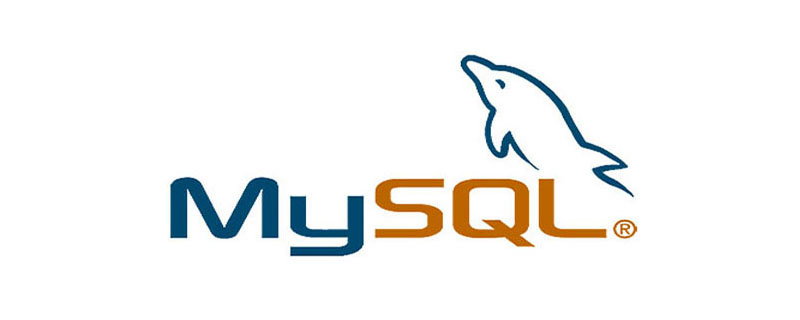
Recommended learning: mysql video tutorial
1. User management
##1.1 Create a new usercreate user '用户名'@'主机名' [identified by [password] '密码'];
Copy after login
create user '用户名'@'主机名' [identified by [password] '密码'];
- The user name needs no explanation, it is the account we use when logging in
- The host name specifies which hosts the user we create can be on To log in, you can use the IP address, network segment, and host name. Local users can use localhost. Allowing login from any host can be represented by the wildcard character %.
- identified by is translated as verification by..., which is the password. The password is divided into plain text and cipher text. The plain text is directly identified by plus 'password', and the cipher text is identified by password 'password' ', the password keyword is added.
- If you use a clear text password, enter the 'password' directly, and it will be automatically encrypted by Mysql when inserted into the database; if you use an encrypted password, you need to use SELECT PASSWORD('password'); to obtain the ciphertext first, and then add it in the statement Add PASSWORD 'Private text'; if the "IDENTIFIED BY" part is omitted, the user's password will be empty.
- Create user in clear text

 ##Create user in ciphertext
##Create user in ciphertext 
View the user table in the mysql library. It should be emphasized that only the root user can view this library. Normally Users do not have permission to query this library.
If we want an ordinary user to view this mysql library, we need to use grant for authorization. Note that authorization work can only be performed by the root user. 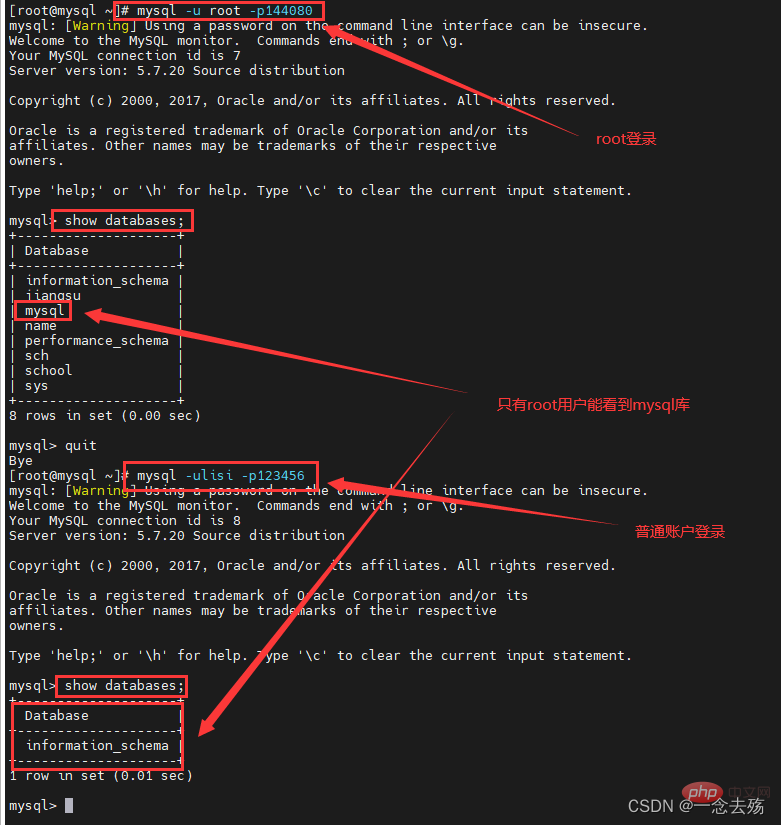
Remote login, that is, remote login to the local database from other hosts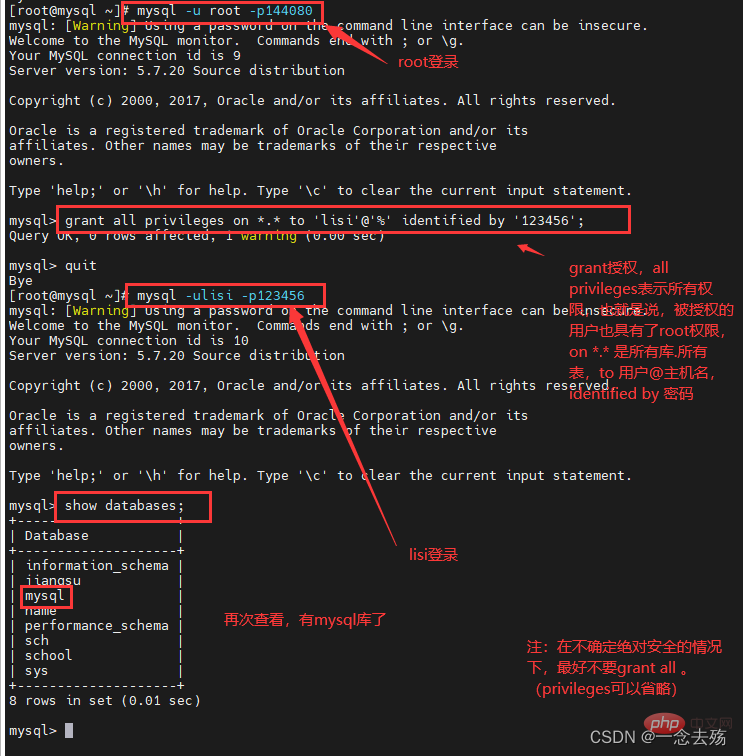
View the mysql.user table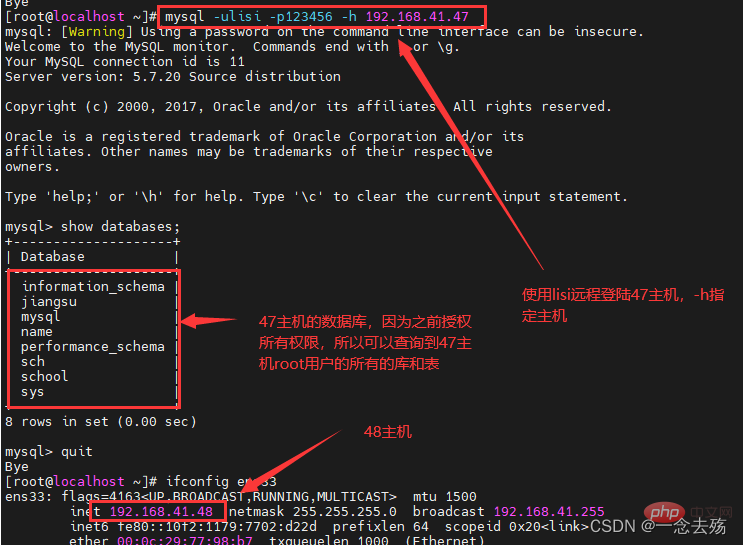
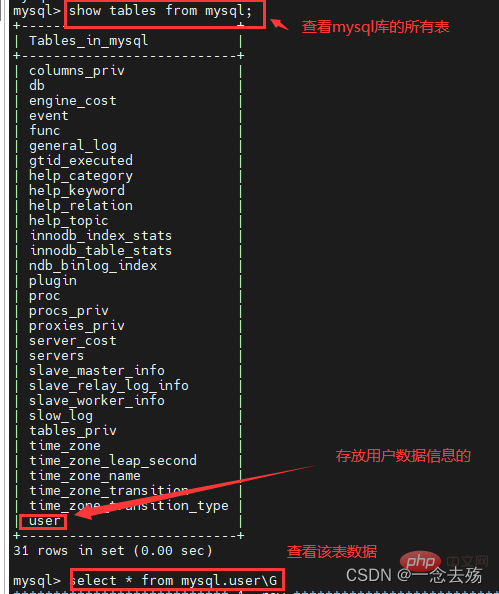

rename user '旧用户名'@'旧主机名' to '新用户名'@'新主机名';
Copy after login
rename user '旧用户名'@'旧主机名' to '新用户名'@'新主机名';
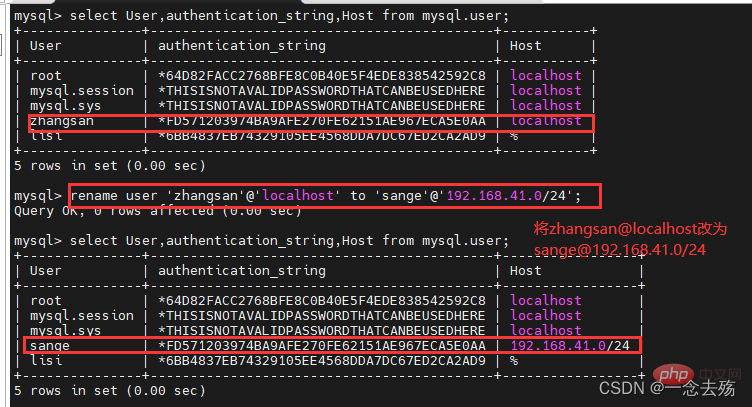

drop user '用户名'@'主机名';
Copy after login
drop user '用户名'@'主机名';
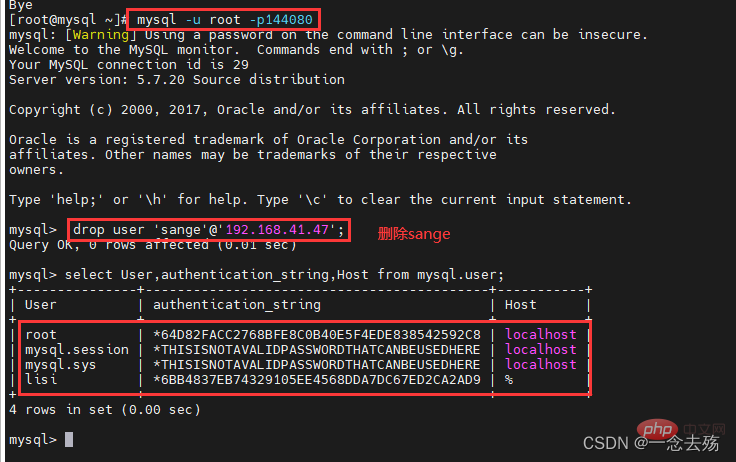
1. Modify current user password
set password = password('新密码')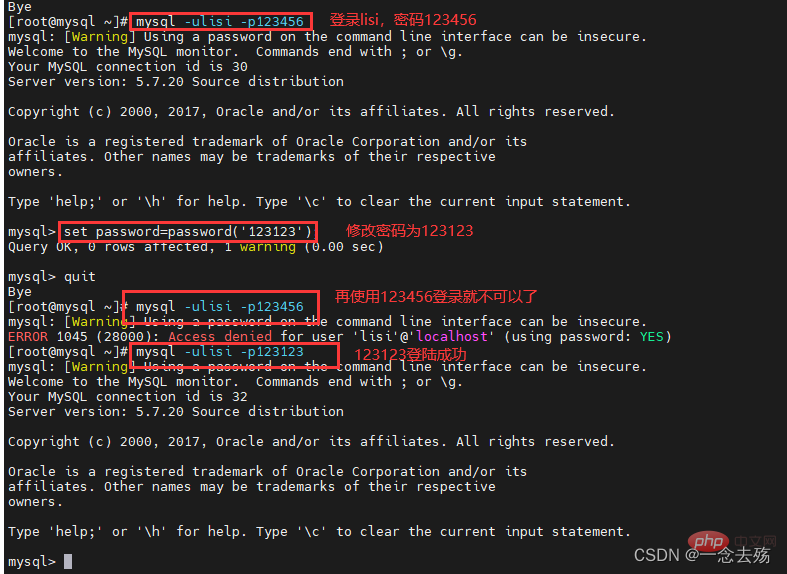 2. Change the password of other users
2. Change the password of other users
set password for '用户名'@'主机名' = password('新密码');普通用户是无法修改其他用户密码的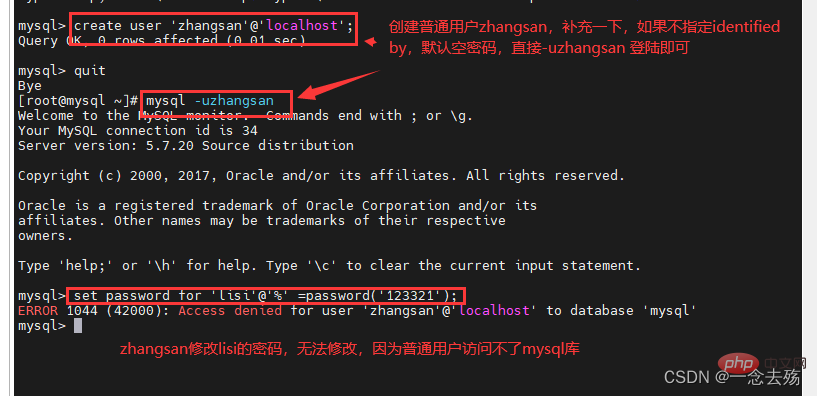
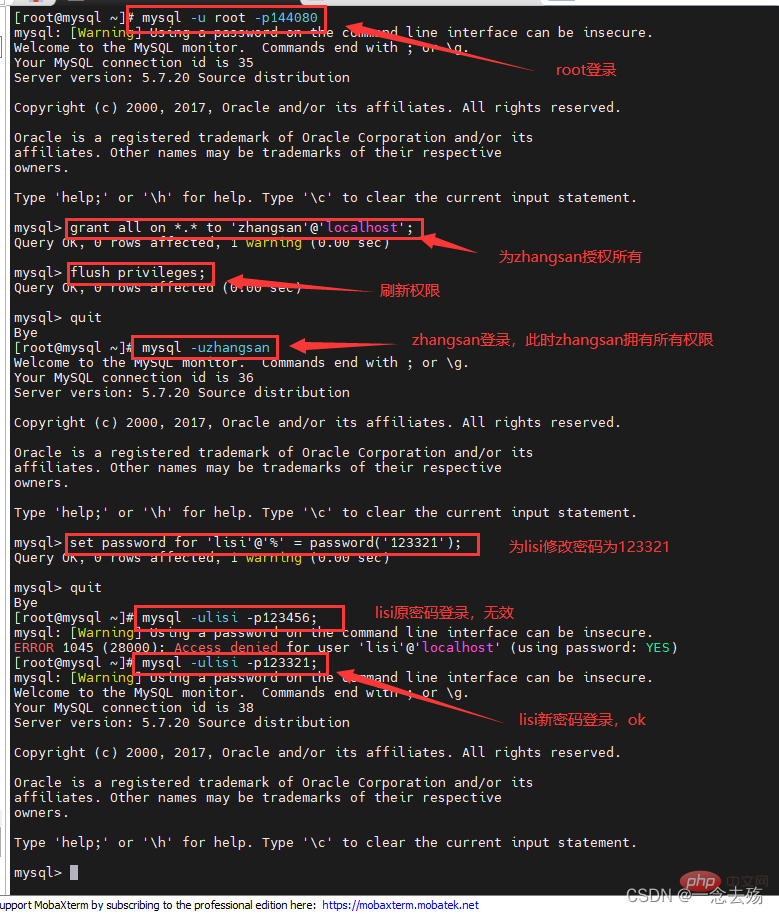 ##1.6 What to do if you forget your password
##1.6 What to do if you forget your password
vim /etc/my.cnf #修改mysql配置文件
[mysqld]
......
skip-grant-tables #在mysqld模块下添加该配置
wq保存退出
systemctl restart mysqld #重启mysql服务
mysql #mysql直接登录
update mysql.user set authentication_string = password('新密码') where User='root';
flush privileges;
退出重新登陆
切记:修改完后一定将配置文件的skip-grant-tables注释或者删掉,不然再执行一次重启数据库,还是可以无密码登录,很危险Copy after login
vim /etc/my.cnf #修改mysql配置文件
[mysqld]
......
skip-grant-tables #在mysqld模块下添加该配置
wq保存退出
systemctl restart mysqld #重启mysql服务
mysql #mysql直接登录
update mysql.user set authentication_string = password('新密码') where User='root';
flush privileges;
退出重新登陆
切记:修改完后一定将配置文件的skip-grant-tables注释或者删掉,不然再执行一次重启数据库,还是可以无密码登录,很危险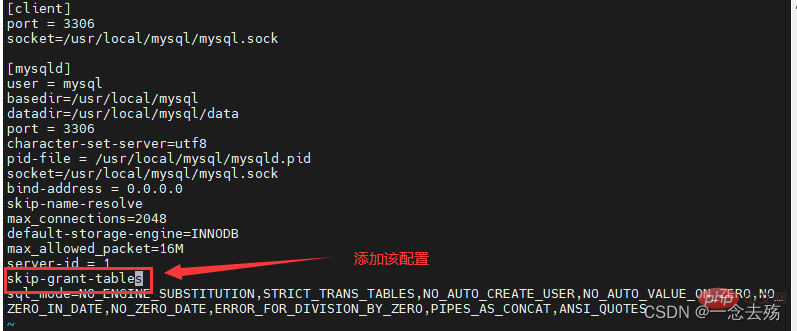
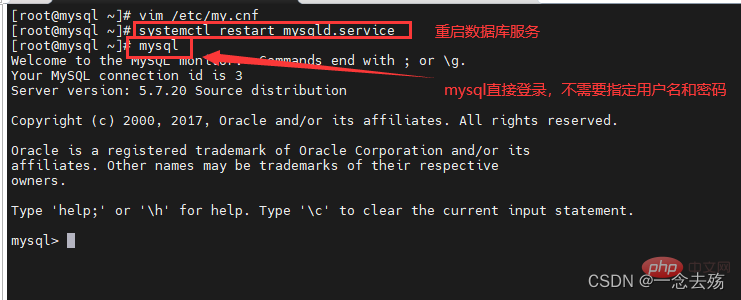
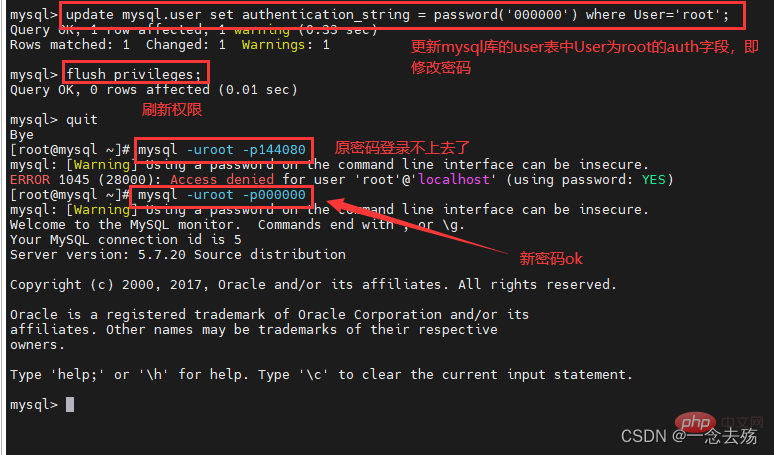
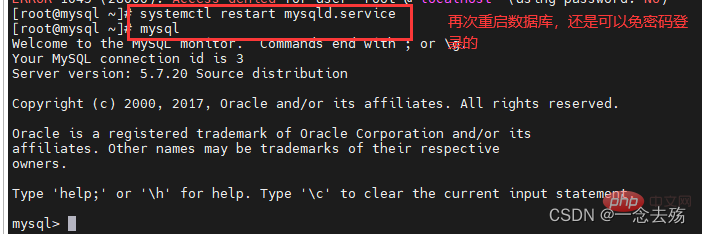
二、授权
2.1 用户授权
grant,授权,通常用于root用户授予普通用户一些执行权限,比如select,insert,update。
grant 权限列表(select|insert|delete|drop|update等等)on 数据库名.表名(*表示所有) to '用户名'@'主机名' [identified by '密码']; 若授权的用户不存在,mysql会先创建一个用户,然后进行授权操作

2.2 查看所授予的权限
show grants for '用户名'@'主机名'; #查看指定用户的权限show grants; #查看当前用户权限

2.3 撤销权限
revoke 权限列表 on 库名.表名 from '用户名'@'主机名'; #从用户XXX撤销XX库.XX表的XX操作的权限

推荐学习:mysql视频教程
The above is the detailed content of Graphical examples analyzing MySQL user management. For more information, please follow other related articles on the PHP Chinese website!

Hot AI Tools

Undresser.AI Undress
AI-powered app for creating realistic nude photos

AI Clothes Remover
Online AI tool for removing clothes from photos.

Undress AI Tool
Undress images for free

Clothoff.io
AI clothes remover

AI Hentai Generator
Generate AI Hentai for free.

Hot Article

Hot Tools

Notepad++7.3.1
Easy-to-use and free code editor

SublimeText3 Chinese version
Chinese version, very easy to use

Zend Studio 13.0.1
Powerful PHP integrated development environment

Dreamweaver CS6
Visual web development tools

SublimeText3 Mac version
God-level code editing software (SublimeText3)

Hot Topics
 1385
1385
 52
52
 MySQL: Simple Concepts for Easy Learning
Apr 10, 2025 am 09:29 AM
MySQL: Simple Concepts for Easy Learning
Apr 10, 2025 am 09:29 AM
MySQL is an open source relational database management system. 1) Create database and tables: Use the CREATEDATABASE and CREATETABLE commands. 2) Basic operations: INSERT, UPDATE, DELETE and SELECT. 3) Advanced operations: JOIN, subquery and transaction processing. 4) Debugging skills: Check syntax, data type and permissions. 5) Optimization suggestions: Use indexes, avoid SELECT* and use transactions.
 How to open phpmyadmin
Apr 10, 2025 pm 10:51 PM
How to open phpmyadmin
Apr 10, 2025 pm 10:51 PM
You can open phpMyAdmin through the following steps: 1. Log in to the website control panel; 2. Find and click the phpMyAdmin icon; 3. Enter MySQL credentials; 4. Click "Login".
 MySQL: An Introduction to the World's Most Popular Database
Apr 12, 2025 am 12:18 AM
MySQL: An Introduction to the World's Most Popular Database
Apr 12, 2025 am 12:18 AM
MySQL is an open source relational database management system, mainly used to store and retrieve data quickly and reliably. Its working principle includes client requests, query resolution, execution of queries and return results. Examples of usage include creating tables, inserting and querying data, and advanced features such as JOIN operations. Common errors involve SQL syntax, data types, and permissions, and optimization suggestions include the use of indexes, optimized queries, and partitioning of tables.
 Why Use MySQL? Benefits and Advantages
Apr 12, 2025 am 12:17 AM
Why Use MySQL? Benefits and Advantages
Apr 12, 2025 am 12:17 AM
MySQL is chosen for its performance, reliability, ease of use, and community support. 1.MySQL provides efficient data storage and retrieval functions, supporting multiple data types and advanced query operations. 2. Adopt client-server architecture and multiple storage engines to support transaction and query optimization. 3. Easy to use, supports a variety of operating systems and programming languages. 4. Have strong community support and provide rich resources and solutions.
 How to use single threaded redis
Apr 10, 2025 pm 07:12 PM
How to use single threaded redis
Apr 10, 2025 pm 07:12 PM
Redis uses a single threaded architecture to provide high performance, simplicity, and consistency. It utilizes I/O multiplexing, event loops, non-blocking I/O, and shared memory to improve concurrency, but with limitations of concurrency limitations, single point of failure, and unsuitable for write-intensive workloads.
 MySQL and SQL: Essential Skills for Developers
Apr 10, 2025 am 09:30 AM
MySQL and SQL: Essential Skills for Developers
Apr 10, 2025 am 09:30 AM
MySQL and SQL are essential skills for developers. 1.MySQL is an open source relational database management system, and SQL is the standard language used to manage and operate databases. 2.MySQL supports multiple storage engines through efficient data storage and retrieval functions, and SQL completes complex data operations through simple statements. 3. Examples of usage include basic queries and advanced queries, such as filtering and sorting by condition. 4. Common errors include syntax errors and performance issues, which can be optimized by checking SQL statements and using EXPLAIN commands. 5. Performance optimization techniques include using indexes, avoiding full table scanning, optimizing JOIN operations and improving code readability.
 MySQL's Place: Databases and Programming
Apr 13, 2025 am 12:18 AM
MySQL's Place: Databases and Programming
Apr 13, 2025 am 12:18 AM
MySQL's position in databases and programming is very important. It is an open source relational database management system that is widely used in various application scenarios. 1) MySQL provides efficient data storage, organization and retrieval functions, supporting Web, mobile and enterprise-level systems. 2) It uses a client-server architecture, supports multiple storage engines and index optimization. 3) Basic usages include creating tables and inserting data, and advanced usages involve multi-table JOINs and complex queries. 4) Frequently asked questions such as SQL syntax errors and performance issues can be debugged through the EXPLAIN command and slow query log. 5) Performance optimization methods include rational use of indexes, optimized query and use of caches. Best practices include using transactions and PreparedStatemen
 How to build a SQL database
Apr 09, 2025 pm 04:24 PM
How to build a SQL database
Apr 09, 2025 pm 04:24 PM
Building an SQL database involves 10 steps: selecting DBMS; installing DBMS; creating a database; creating a table; inserting data; retrieving data; updating data; deleting data; managing users; backing up the database.




